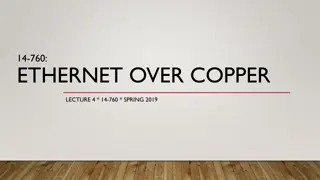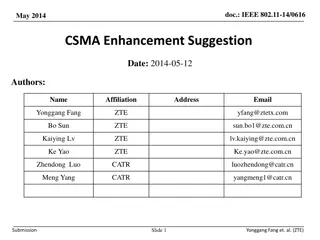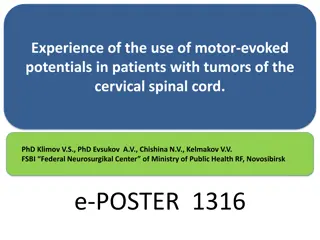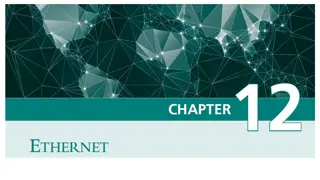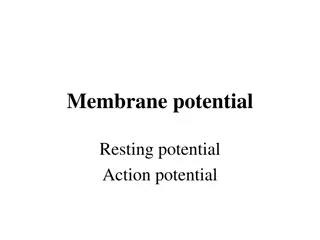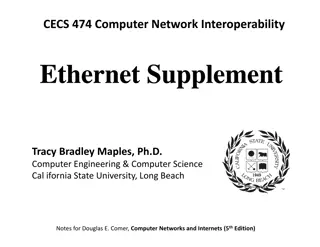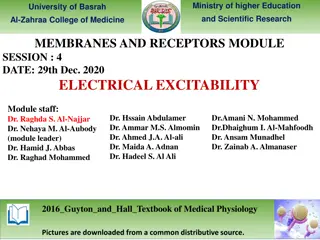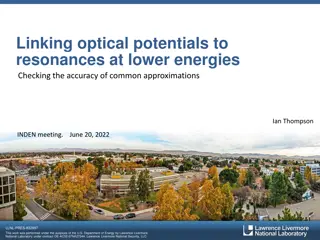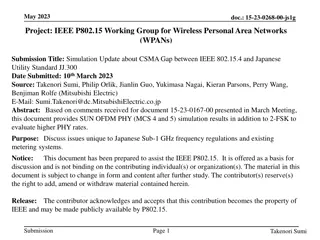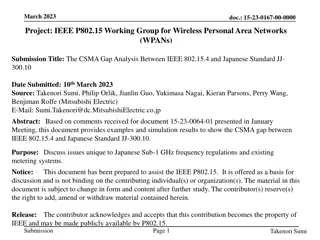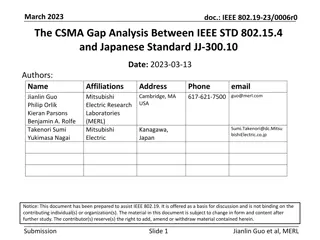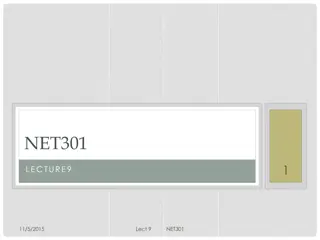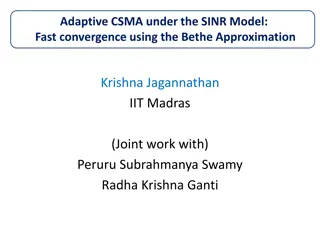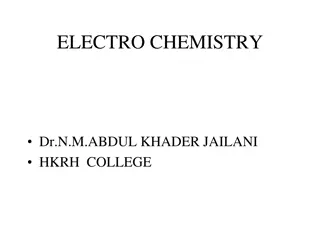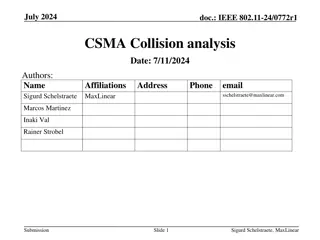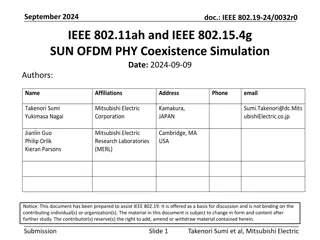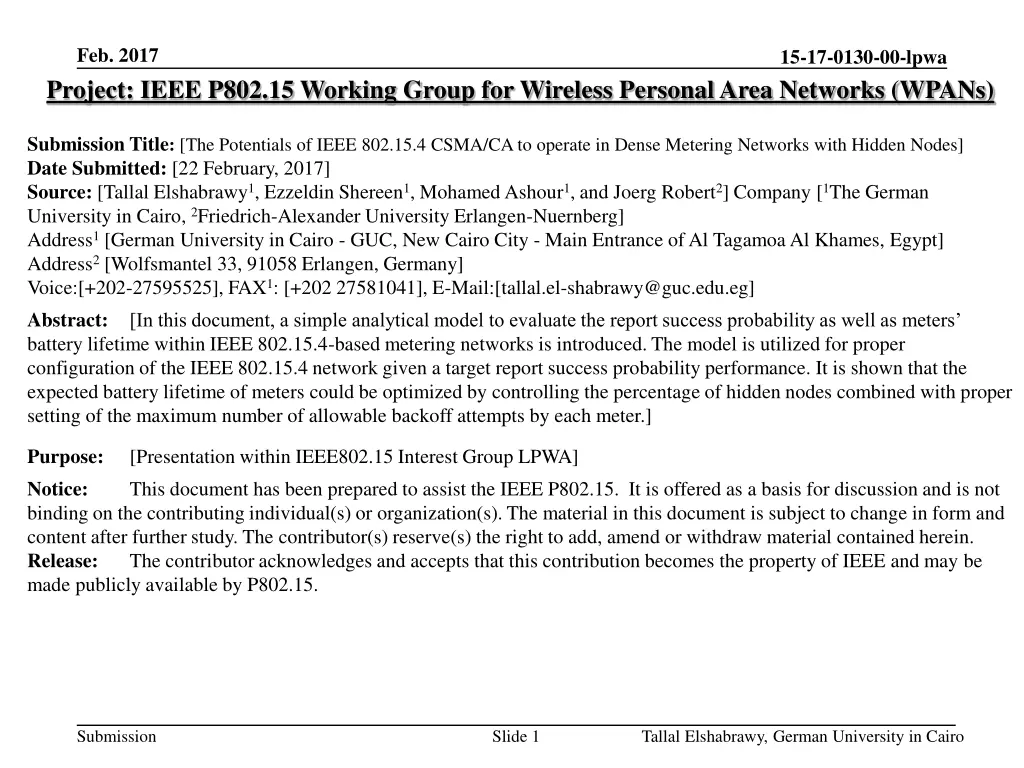
Optimizing IEEE 802.15.4 CSMA/CA for Dense Metering Networks
"Explore the potentials of IEEE 802.15.4 CSMA/CA in dense metering networks, optimizing report success probability and battery lifetime through controlling hidden nodes and backoff attempts. A detailed analytical model for network configuration is presented."
Download Presentation

Please find below an Image/Link to download the presentation.
The content on the website is provided AS IS for your information and personal use only. It may not be sold, licensed, or shared on other websites without obtaining consent from the author. If you encounter any issues during the download, it is possible that the publisher has removed the file from their server.
You are allowed to download the files provided on this website for personal or commercial use, subject to the condition that they are used lawfully. All files are the property of their respective owners.
The content on the website is provided AS IS for your information and personal use only. It may not be sold, licensed, or shared on other websites without obtaining consent from the author.
E N D
Presentation Transcript
Feb. 2017 Project: IEEE P802.15 Working Group for Wireless Personal Area Networks (WPANs) 15-17-0130-00-lpwa Submission Title: [The Potentials of IEEE 802.15.4 CSMA/CA to operate in Dense Metering Networks with Hidden Nodes] Date Submitted: [22 February, 2017] Source: [Tallal Elshabrawy1, Ezzeldin Shereen1, Mohamed Ashour1, and Joerg Robert2] Company [1The German University in Cairo, 2Friedrich-Alexander University Erlangen-Nuernberg] Address1 [German University in Cairo - GUC, New Cairo City - Main Entrance of Al Tagamoa Al Khames, Egypt] Address2 [Wolfsmantel 33, 91058 Erlangen, Germany] Voice:[+202-27595525], FAX1: [+202 27581041], E-Mail:[tallal.el-shabrawy@guc.edu.eg] Abstract:[In this document, a simple analytical model to evaluate the report success probability as well as meters battery lifetime within IEEE 802.15.4-based metering networks is introduced. The model is utilized for proper configuration of the IEEE 802.15.4 network given a target report success probability performance. It is shown that the expected battery lifetime of meters could be optimized by controlling the percentage of hidden nodes combined with proper setting of the maximum number of allowable backoff attempts by each meter.] Purpose: Notice: binding on the contributing individual(s) or organization(s). The material in this document is subject to change in form and content after further study. The contributor(s) reserve(s) the right to add, amend or withdraw material contained herein. Release: The contributor acknowledges and accepts that this contribution becomes the property of IEEE and may be made publicly available by P802.15. [Presentation within IEEE802.15 Interest Group LPWA] This document has been prepared to assist the IEEE P802.15. It is offered as a basis for discussion and is not Submission Slide 1 Tallal Elshabrawy, German University in Cairo
Feb. 2017 15-17-0130-00-lpwa The Potentials of IEEE 802.15.4 CSMA/CA to operate in Dense Metering Networks with Hidden Nodes Tallal Elshabrawy1, Ezzeldin Shereen1, Mohamed Ashour1, and Joerg Robert2 1The German University in Cairo, 2Friedrich-Alexander University Erlangen-Nuernberg Submission Slide 2 Tallal Elshabrawy, German University in Cairo
Feb. 2017 15-17-0130-00-lpwa Motivation Dense Metering Networks Thousands of Meters Periodic Reports Inevitable Hidden Nodes Dimensioning and Parameter Configuration of 802.15.4 CSMA/CA-based Metering Networks Target Report Success Probability Maximize Battery Lifetime Submission Slide 3 Tallal Elshabrawy, German University in Cairo
Feb. 2017 15-17-0130-00-lpwa Metering Network Model Dense Meters Population Periodic Reporting CAP CSMA/CA Star Configuration between Meters and Basestation Each Meter Mt has q% of Hidden Nodes Collisions at Base station Submission Slide 4 Tallal Elshabrawy, German University in Cairo
Feb. 2017 15-17-0130-00-lpwa Model Parameters for Success Report Probability Description Number of Meters in Network Percentage of total meters that are hidden with respect to an IEEE 802.15.4 device of interest IEEE 802.15.4 Packet Length for Metered Data in terms of Number of Timeslots Aggregate Meters Report Arrival Rate Aggregate CCA Attempts Arrival Rate Probability of an IEEE 802.15.4 device successfully passing CCA (i.e., attempting transmission) Probability of a successful IEEE 802.15.4 transmission Maximum Number of Allowable Backoffs Minimum Backoff Exponent Maximum Backoff Exponent Success Report Probability Parameter ?? ? ?? ?? ???? ???? ?? ??? ?? ????? ????? ??? Submission Slide 5 Tallal Elshabrawy, German University in Cairo
Feb. 2017 15-17-0130-00-lpwa Report Success Probability Analytical Model Poisson-Based Model Aggregate CCA Attempts Rate ???+1 ?? 1 1 ?? ????= ?? ?? Collision Avoidance Probability w.r.t to Visible Nodes Probability of Collision Free Transmission ? ??? ? ??? ??= ?= ? 1 ? ?????? ??? 1 + ??+ 1 1 ? 1 ? ?????? Collision Avoidance Probability w.r.t to Hidden Nodes Successful Report Probability (i.e., less than ?? ??? CCA attempts) ?= ? ??????????? ?? 1 ? ??????? ?? ??? ???=?????? ?? Submission Slide 6 Tallal Elshabrawy, German University in Cairo
Feb. 2017 15-17-0130-00-lpwa Model Parameters for Battery Lifetime Description Drained Current when an IEEE 802.15.4 device is in Receive mode Drained Current when an IEEE 802.15.4 device is in Transmit mode Drained Current when an IEEE 802.15.4 device is in Idle mode Effective Average Drained Current by an IEEE 802.15.4 Device. Percentage of Time Spent in Receive mode Percentage of Time Spent in Transmit mode Percentage of Time Spent in Idle mode Expected Meter Battery Lifetime Meter Battery Capacity Parameter ??? ??? ??? ???? ??? ??? ??? ?? ?? Submission Slide 7 Tallal Elshabrawy, German University in Cairo
Feb. 2017 15-17-0130-00-lpwa Battery Lifetime Analysis IEEE 802.15.4 Device States: Transmit ???=???? ??(????????) Receive CCA Checks ACK Reception ???=???? Probability of Passing First CCA 0.4??1 + ????1 + ???????? ?? ????1= 1 1 ? 1 ? ???????????? ?? Idle/Sleep ???= 1 ??? ??? ????= ??????+ ??????+ ?????? ?? ???? ?? = Submission Slide 8 Tallal Elshabrawy, German University in Cairo
Feb. 2017 15-17-0130-00-lpwa OMNET++ Simulation Model Note: external interference disabled ??? ??? ?? Communication Range Vs Percentage of Hidden Nodes 1 0.9 0.8 Percentage of hidden Nodes q 0.7 0.6 0.5 0.4 0.3 0.2 0.1 0 0 20 40 Communication Range (m) 60 80 100 120 Submission Slide 9 Tallal Elshabrawy, German University in Cairo
Feb. 2017 15-17-0130-00-lpwa Analytical Model Verification q = 0 q = 0.25 The analysis is an upper bound 1 1 Report Success Probability PRS Report Success Probability PRS 0.8 0.8 0.6 0.6 Analytical Model BEmin = 3, BEmax = 3 BEmin = 3, BEmax = 8 BEmin = 8, BEmax = 8 Analytical Model BEmin = 3, BEmax = 3 BEmin=3, BEmax = 8 BEmin = 8, BEmax = 8 0.4 0.4 0.2 0.2 It is better to increase ????? and ???ax 0 0 1000 1200 1400 1600 1800 2000 1000 1200 1400 1600 1800 2000 Number of 802.15.4 enabled Meters NM Number of 802.15.4 enabled Meters NM q = 0.5 q = 0.75 1 1 Analytical Model BEmin = 3, BEmax = 3 BEmin = 3, BEmax = 8 BEmin = 8, BEmax = 8 Analytical Model BEmin = 3, BEmax = 3 BEmin = 3, BEmax = 8 BEmin = 8, BEmax = 8 Report Success Probability PRS Report Success Probability PRS 0.8 0.8 0.6 0.6 Performance strongly impact by hidden nodes percentage 0.4 0.4 0.2 0.2 0 0 1000 1200 1400 1600 1800 2000 1000 1200 1400 1600 1800 2000 Number of 802.15.4 enabled Meters NM Number of 802.15.4 enabled Meters NM Submission Slide 10 Tallal Elshabrawy, German University in Cairo
Feb. 2017 15-17-0130-00-lpwa Mapping Hidden Nodes to Tx Power TI CC2630 Datasheet ???? to Percentage of Hidden Nodes from OMNET++ Model in Urban Environment 20 ? ??? ?? ??????????? 105 10 Pathloss Exp n = 3.5 Pathloss Exp n = 2.7 17.5 5032 ????= 10 15 Transmission Power PTx (dBm) 12.5 Variable Value 10 7.5 6.1 ?? 0 ??? ?? ????? 9.1 ?? 5 ??? ?? ????? 5 ??? 2.5 5.9 ?? 1 ?? 100 ??? ??? ??? 0 -2.5 -5 Rx Sensitivity ?? -7.5 225 ?? (??2032 ???? ???????) -10 0 0.1 0.2 0.3 Percentage of Hidden Nodes q 0.4 0.5 0.6 0.7 0.8 0.9 1 Submission Slide 11 Tallal Elshabrawy, German University in Cairo
Feb. 2017 15-17-0130-00-lpwa Contour Plot for ??? Performance versus ? and ?? (???)given ??= 1000 and ??= 6 10 0.15 0.4 0.45 0.5 0.55 0.6 0.9 0.05 9 0.8 0.85 0.2 0.75 (Max)) 0.25 0.3 0.35 0.95 0.7 0.65 8 0.1 Maximum Number of Backoffs ( NB 7 0.15 0.4 0.45 0.5 0.55 0.6 0.2 0.25 0.3 0.35 0.9 6 0.75 0.8 0.85 0.7 0.65 0.95 5 0.4 0.45 0.5 0.55 0.6 4 0.95 0.9 3 0.75 0.65 0.7 0.8 0.85 2 0.1 0.2 0.3 0.4 0.5 0.6 0.7 0.8 0.9 Percentage of Hidden Nodes (q) Submission Slide 12 Tallal Elshabrawy, German University in Cairo
Feb. 2017 15-17-0130-00-lpwa Contour Plot for ?? Performance versus ? and ???given ??= 1000 and ??= 6, ??= 6? and Urban Environment Pathloss ? = ?.? ?? 10 Mild Urban Env. 45 30 50 55 9 35 60 0.95 40 (Max)) ? = 0.15 ???= 2.5 ??? 8 Maximum Number of Backoffs ( NB 60 7 30 45 35 50 6 55 0.95 40 60 ???= 3 ?? 5 (T) PRS 30 45 35 4 50 40 60 55 ????? 63.5 months. 60 0.95 63.5 3 63.5 50 66 55 60 66 63.5 2 0.1 0.2 0.3 0.4 0.5 0.6 0.7 0.8 0.9 Percentage of Hidden Nodes (q) Submission Slide 13 Tallal Elshabrawy, German University in Cairo
Feb. 2017 15-17-0130-00-lpwa Contour Plot for ?? Performance versus ? and ???given ??= 1000 and ??= 6, ??= 6? and Urban Environment Pathloss ? = ?.? ?? 10 Severe Urban Env. 9 (Max)) 0.95 ? = 0.3 ???= 15 ??? (might not be affordable) 8 Maximum Number of Backoffs ( NB 20 7 20 20 (T) 22 PRS 6 22 24 22 26 0.95 5 24 20 28 ???= 5 ?? 26 30 28 4 24 30 26 0.95 22 3 ????? 22 months. 28 20 30 2 0.1 0.2 0.3 0.4 0.5 0.6 0.7 0.8 0.9 Percentage of Hidden Nodes (q) Submission Slide 14 Tallal Elshabrawy, German University in Cairo
Feb. 2017 15-17-0130-00-lpwa Contour Plot for ?? Performance versus ? and ?? and Urban Environment Pathloss ? = ?.? ???given ??= 1000 and ??= 6, ??= ?? 10 Relaxing Reporting Rate 30 35 40 30 0.95 35 40 9 (Max)) 8 Maximum Number of Backoffs ( NB ? = 0.74 ???= 4 ??? 30 7 35 40 6 0.95 30 35 40 45 45 5 (T) PRS 50 ???= 4 ?? 55 4 0.95 60 50 3 63.5 66 68.5 40 35 30 ????? 50 months. 45 55 0.95 2 0.1 0.2 0.3 0.4 0.5 0.6 0.7 0.8 0.9 Percentage of Hidden Nodes (q) Submission Slide 15 Tallal Elshabrawy, German University in Cairo
Feb. 2017 15-17-0130-00-lpwa Conclusions & Further Proposals Report Success Probability is improved by setting the backoff exponents to the maximum value Report Probability Performance is affected by Hidden Nodes Percentage and Maximum Number of Backoffs Controlling Hidden Nodes by Transmit Power can signifcantly improve performance Further Proposals Controlling Hidden Nodes by Enhancing Sensing Algorithms Controlling Hidden Nodes by Base station Time Scheduling of Multiple PAN IDs Submission Slide 16 Tallal Elshabrawy, German University in Cairo
Feb. 2017 15-17-0130-00-lpwa Thank You Discussion? Submission Slide 17 Tallal Elshabrawy, German University in Cairo


